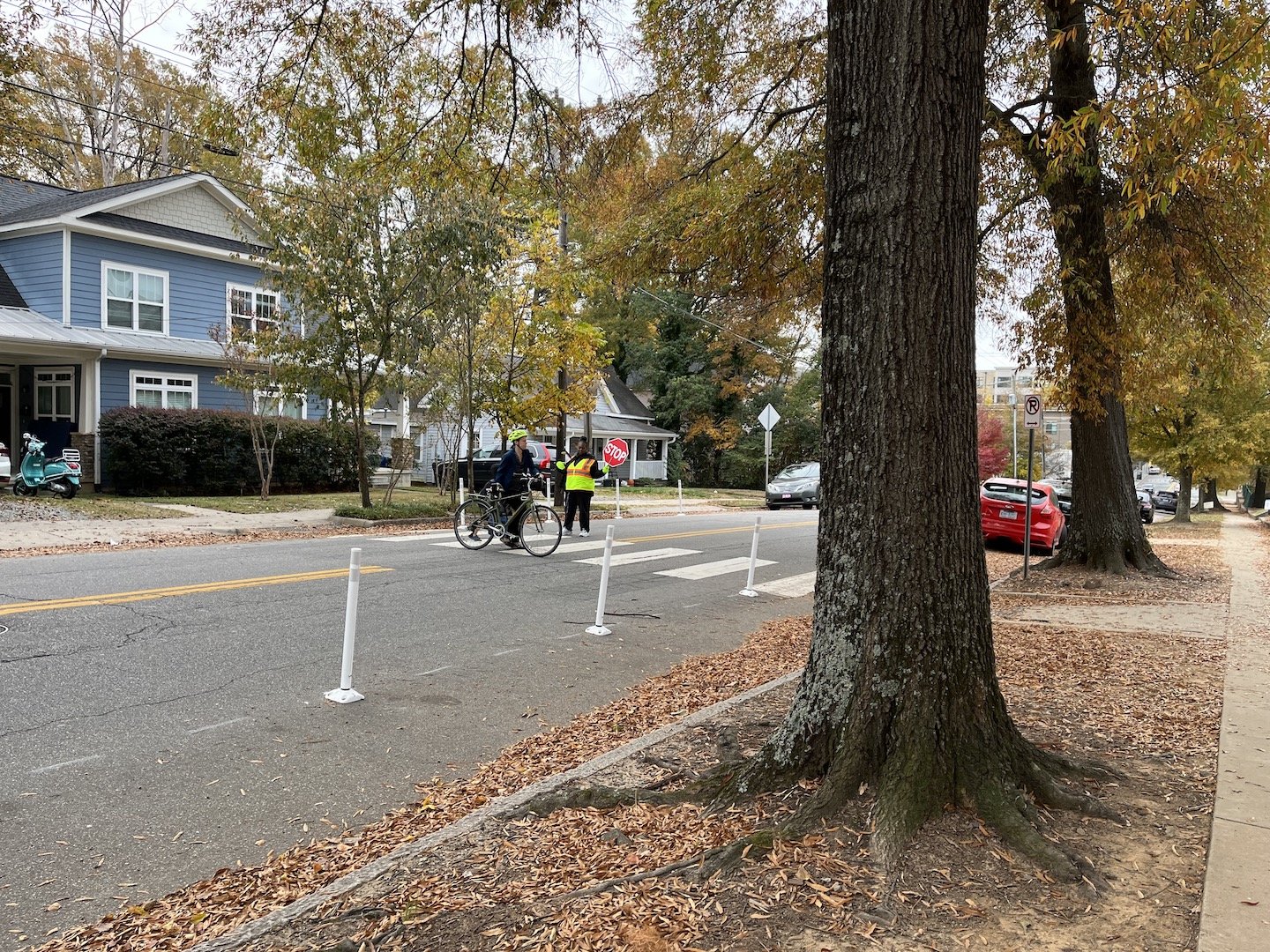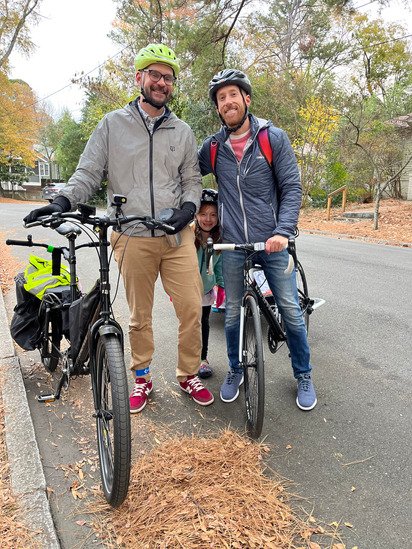The Family Responsibility Zone plan was rolled out in many DPS elementary schools a few weeks ago, and while families are still figuring out their plans despite the latest winter temperatures, we would like to share another parent’s experience in organizing walking and biking groups and the use of GoDurham buses to get to school.
This will target older students (middle school), giving them the opportunity to expand their independence and transportation options, while connecting with their communities and neighborhoods.
Erik Landfried, Bike Durham member and volunteer, explains how organizing with other parents goes a long way and initiates habits that students then build into their routine trip to school.
For the better part of the past seven years, our son and daughter have walked or biked to elementary school nearly every day. We are fortunate to live in a part of Durham where walking and biking is safe and we live only ½ mile from the nearest elementary school. Taking our kids to and from school was always one of the highlights of the day for us as parents. We would talk about school or something fun coming up, see friends along the way, and get some exercise while we did it. When he was old enough, our son gained a lot of independence by being able to walk or bike on his own.
Our son started 6th grade this year, which presented a new commuting challenge, but also a new opportunity. The school he now attends is nearly three miles away and while still in a relatively walkable and bikeable part of Durham, the distance and difficulty crossing some streets meant that he did not feel comfortable biking there alone.
Organize with other parents to gain momentum and help other families. BIKE BUSES!
As Erik explains, there is safety and power in numbers, especially when sharing the road with cars and in the absence of dedicated bike paths or lanes:
My friend’s son was in a similar situation, so his father and I got organized. We know there is safety (and fun!) in biking in numbers, so we recruited other families to join us. We contacted the parents of some 7th graders who had biked to middle school the previous year to find out their routine. We reached out on the PTA listserv and talked with families who have kids we thought might be interested in biking together. We discovered that there were a lot of folks interested in not having to drive their kid to school every day or rely solely on the school bus, including some that don’t live in our neighborhood.
A few parents tested out the bike-to-school route on a weekend and got to do a trial run with the kids during the Summer Bridge program at the middle school (a fantastic program, by the way). We set up a WhatsApp group for the parents to stay in touch and the kids exchanged contact info if they had their own device. During the first week of school, a few parents rode with the kids to and from school, testing out different routes and ways to safely get through difficult intersections. By Week 2, the kids biked to school on their own. Most mornings, they meet up at the same elementary school most had walked or biked to when they were younger and take their “bike bus” to middle school.
Students on their way to school - May 2024
How can public transit help?
There have been challenges for sure - bad weather, the timing of before or after school programs, transporting trumpets - but each time the parents and kids came up with a solution. I took some of the kids to school on the GoDurham bus one morning to teach them how to ride and where to get on and off the bus. Now several of them use the city bus when they need to transport something or the weather is too icky to bike. And on days when driving is more convenient, we carpool, using the WhatsApp group to organize rides. Families who had originally signed up for the school bus realized they no longer needed it, lessening the load for a school system struggling to hire enough bus operators.
Students using a GoDurham bus on a rainy day - May 2024
Best of all, we’ve formed a community of parents and kids who help each other out. The kids have expanded their independence and we’ve created multiple options for helping them get to and from school, which makes our lives much easier.
Not everyone can do this: what are the takeaways and what can we all do?
I write this knowing that what’s worked for us is not going to work for everyone. Many schools in Durham are sadly not safe to walk or bike to or the distance to them is too far. Some don’t have GoDurham service nearby (though more do than you might think - the DPS Safe Routes To School team has produced these handy transit guides!). But there are opportunities out there. And with the change in how middle schools are districted next fall, this is the perfect time to explore what you can do to give your kids some independence and a healthier commute and make your lives easier at the same time.
Here are a few suggestions for getting started:
Make a plan this summer. What are the options for your kid(s) to get to school? What are your needs as a family?
Test it out. If it’s feasible, walk or bike with your kid(s) to their new (or old!) school. Or try a GoDurham bus. Do it on a weekend if you can’t on a weekday.
Reach out, connect with other parents. Contact other families at your kids’ school through a PTA listserv or other type of school communication or simple word of mouth.
Get organized. Create a WhatsApp group or whatever form of communication works best for you. Pick a location and time to meet if you’re doing a walk or bike bus. Do a test run before the school year starts.
Start small. We started with the bike bus, but tacked on GoDurham and carpooling later. You could even just try it one day a week to start.
Keep communicating and iterating. Figure out what works best for everyone’s situation.
Have fun! Walking is fun. Biking is fun. Taking the bus is fun. Especially with lots of friends. And having lots of options and a community to lean on relieves stress, which is also fun!






















